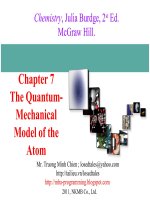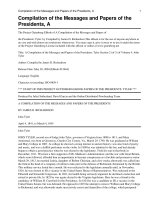logical conecters
Bạn đang xem bản rút gọn của tài liệu. Xem và tải ngay bản đầy đủ của tài liệu tại đây (111.9 KB, 8 trang )
<span class='text_page_counter'>(1)</span><div class='page_container' data-page=1>
Group8: H.Linh_Quyen_Van
<b>Logical connectors</b>
<b>1,AND</b>
- “ AND” can link its sentence with a unit comprising several sentences
- Eg:
<b>2. ENUMERATION</b>:
- Enumerative conjuncts indicate a listing of what is being said.
- Eg: First(ly), second(ly)………..Furthermore……..
<b>3. ADDITION</b>:
- The addition relationship is often conveyed by the 2 subclasses of
additive conjuncts, reinforcing and equative conjuncts
*Eg: also, equally,………
- Additive adjuncts specify that part of the sentence is an addition to
what has been previously mentioned or implied.
* Eg: Too, neither/nor………..
<b>4. TRANSITION</b>:
- “ Now” introduces a new stage in the sequence of thought.
*Eg: We have settled that at last. Now, what was the other thing we
wanted to discuss.
- “ As for” introduces a related topic.
* Eg: Mary has several close friends. As for John, he is always
surrounded by friends.
- certain other expressions mark a transition, but they can also begin
discussion: with reference to, with respect to, with regard to.
<b>5. SUMMATION</b>:
- summative conjuncts and style disjunct such as in brief can be used to
indicate this.
* Eg: In all, I will sum up by saying, I shall conclude by saying.
</div>
<span class='text_page_counter'>(2)</span><div class='page_container' data-page=2>
- Indicators of an apposition can be used to refer back to previous
sentences: for example, another way of putting it is….
<b>7. RESULT</b>:
- Several result conjuncts indicate that a sentence expresses the
consequence or result of what was said before.
*Eg: As a result, the consequence (of that)………
<b>8.INTERFENCE</b>:
- An interference from what is implicit in the preceding sentence or
sentences can be indicated by an inferential conjunct.
* Eg: In other words, In that case, If so, If not….
<b>9. OR:</b>
- “ Or” introduces a reformulation or replacement. It can be followed by
conjuncts that have the same function,or they alone can be used.
*Eg:+ Reformulatory conjuncts: ( Or) rather, (Or) in other words
+ Replacive conjucts: Or again, (Or) on the other hand.
<b>10.BUT:</b>
- The relationships between sentences linked by “ but” are the same as
those between clauses linked by “but”, though the contrast may be with
a preceding unit consisting of more than one sentence.
<b>11. CONTRAST</b>:
- A contrast can be indicated by antithetic conjuncts.
* Eg: On the contrary, by comparison, instead,….
<b>12. CONCESSION:</b>
- Concessive conjucts signal the unexpected, surprising nature of what is
being said in view of what was said before.
* Eg: however, still, besides…
- Most of the concessive conjuncts can be paraphrased by a concessive
subordinate clause introduced by “ though” or “ although”
</div>
<span class='text_page_counter'>(3)</span><div class='page_container' data-page=3>
is true”. They include the attitudinal disjuncts “ actually,
admittedly,certainly…”
- Several attitudinal disjuncts suggest that the context of the sentence to
which they are related may not be true in reality: nominally,
officially,technically,……..
<b>13. FOR</b>
- The conjunct “ for” indicates that what is said the reason for
mentioning what has been said previously
*Eg:
<b>II.Substitution</b>
:<b>1. Definition:</b>
- Like ellipsis, substitution is a device for abbreviating and for avoiding
repetition.
<b>2. Classification</b>
:<b>a-Pro-forms for noun phrases and their constituents</b>
* Def: The most obvious pro-form for noun phrases are the 3th person
pronouns.
* Eg: <i>John and Mary</i> stole a toy from my son. Their mother told <i>them</i> to
return the toy, but <i>they</i> said it was <i>theirs</i>.
<b>b- Pro-forms for adverbials</b>:
*Def: Sometimes relater can be pro-forms for time adjuncts, principally
them, but also that when it functions as subject and when the verb is
intensive.
* Eg: We saw John at <i>eight on Monday evening.</i> We told him <i>then</i> that
we would be coming to the party.
<b>c- Pro-forms for predicate and predication:</b>
<i>* Auxiliaries as pro-forms</i>:
</div>
<span class='text_page_counter'>(4)</span><div class='page_container' data-page=4>
B: I think Bob does too( = drives a car)
*<i>Complex pro-form:</i>
- The substitute may be a complex pro-form a combination of one or
more auxiliaries with the pro-form: so, that...
<i>* Classification:</i>
-<i><b>So do type</b></i>: so + auxiliary +(S)
- Eg: A: John drives a car
B: So does Bob
<i><b>- So…do type</b></i>: so + S + auxiliary
-Eg: A: Look! That man seems lost
B: So he does
- <i><b>Do so type</b></i>: S + Auxiliary+do+so
- Eg: A: Have you sent your donation
B: I did so yesterday
- <i><b>Do that type:</b></i> S+ Auxiliary+do+that
-Eg: A: Do you know who broke the television?
B: I heard John did that.
-<i><b>Do it type</b></i>: S+ auxiliary+do+it.
-Eg: A: Your brother said he was going to send a letter of protest to
the president.
B: He did it last week.
<i><b>3. Relation</b></i>
:<b>a. Relation to verb clauses:</b>
- All lexical verbs allow substitution by “ <i>do</i>” or other auxiliaries
and by the complex pro-form types “ <i>so do…” so do</i>”. But several
of the verb classes don’t allow the full range of substitutions. For
example: verb of bodily sensation such as feel admit only the
auxiliaries and the types “<i>So do</i>” and “ <i>so…do</i>”
</div>
<span class='text_page_counter'>(5)</span><div class='page_container' data-page=5>
B:-I know he does ( = I know he feel much better)
- Yes and so do I
- Yes, so he does
<b>b- Relation to adverbials</b>:
-Def: the pro-forms needn’t cover a time or place adjunct in the
antecedent predicate.
-Eg: A: John paid for the ticket tonight
B: Yes, he did so last week too.
<b>c- Co-referenentiality of subjects</b>.
- Def: The <i><b>so do type</b></i> is used only if the student of the clause is not
co-referential with that of the antecedent clause.
-Eg: A: John buys his drinks at the local supermarket
B: So do we
<b>d- Operator in pro-forms:</b>
The <i><b>do so</b></i>, <i><b>do that</b></i> and <i><b>do it</b></i> pro-forms require an additional do
as operator
-Eg: A: Do they buy their drink at the local supermarket
B: yes, but we don’t do so
<b>e- Exclusive of pro-form types from certain clauses</b>
- there are severe restrictions on the occurrence of auxiliaries as
pro-form in <i><b>non-finite clauses</b></i>
- Eg:A: Peter hunts rabbits
B: - Yes, I have noticed him doing
- Yes, I have watched him do
- I know, he wanted me to do too
<b>f- The pro-form not and so</b>
- Not can be a negative pro-form for the predicate
* Eg: A: Bill would have taken the book
</div>
<span class='text_page_counter'>(6)</span><div class='page_container' data-page=6>
<b>Exercises</b>
<b>Logical connectors</b>
<i>Questions:</i>
1. List the name of logical connecter?
2. give an example about Enumeration?
3. T/F:
a. A contrast can not be indicated by antithetic conjuncts.
b. Concessive conjuncts signal the unexpected, surprising nature of what is
being said in view of what was said before.
c. An inference from what is explicit in the preceding sentence or sentences
can be indicated by an inferential conjunct.
d. The addition relationship is often conveyed by the two subclasses of additive
conjuncts, reinforcing and equative conjuncts.
<b>Substitution</b>
Part 1: Review theory:
<i>1. Fill in the blank:</i>
Like ellipsis, substitution is a device for……(1)………….and avoiding ……(2)
……..
Substitution are normally………(3)…….
The most obvious pro-form for noun phrases are……(4)……..pronoun.
<i>2. answer the questions:</i>
a. Lists all kind of pro-form?
b. What is the complex pro-form?
Part 2: Practical exercises:
<i>Exercise 1: Reply in the affirmative to each of these questions below, using a </i>
<i>pro-form for the part of sentence underlined.</i>
Eg:
</div>
<span class='text_page_counter'>(7)</span><div class='page_container' data-page=7>
B: Yes, I have one.
1. Do you have any stamps?
2. Have you seen both of those plays?
3. Is it true that each man had a gun?
4. Are there enough seats for everyone?
5. I have your ticket. Do you have my ticket?
6. Are these gloves your gloves?
7. Did other people hear what he said?
8. Is that the waiter who served us?
<i>Exercise 2: Reply in the affirmative questions below, using a pro-form for the </i>
<i>phrase underlined:</i>
1. Will you be in your room tomorrow morning?
2. Will you be in your room tomorrow morning?
3. If we meet tomorrow morning, will tomorrow morning be convenient for
you?
4. If we meet in your room, will your room be all right?
5. Can I get to Boston by taking this side rood?
<i>Exercise 3: Give a detailed analysis, in terms used in the Grammar</i>,<i> of the </i>
<i>pro-form used by B in the exchanges below:</i>
Eg:
A: Are you ready?
B: Yes, I am.
<i>am</i>: is used as a pro-form for the first person singular, present tense.
1. A: Is Tom still waiting?
B: Yes, he is.
2. A: Have you got any matches?
B: Yes, I have.
</div>
<span class='text_page_counter'>(8)</span><div class='page_container' data-page=8>
B: I think he has.
4. A: Robert has a car.
B: I think he does.
5. A: You drive well yourself.
B: I did.
<i>Exercise 4: explain the grammatical function of so in the following examples:</i>
1. A: Is there going to be a general election?
B: I believe so.
2. A: There’s going to be a general election.
B: So I believe.
C: So do I.
3. A: You told her the secret.
B: That isn’t so.
</div>
<!--links-->









